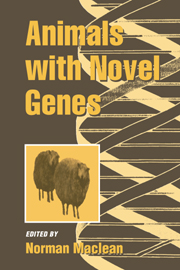2 - Transgenic insects
Published online by Cambridge University Press: 21 October 2009
Summary
Introduction
For many years, transgenic research in eukaryotic organisms has been dominated by only three species, namely Drosophila, the mouse and yeast. Perhaps at the forefront, research with the fruit fly Drosophila melanogaster has, to an unprecedented degree, shown how transgenic technology can be used not only to manipulate genes, but also to extend our understanding of molecular genetics. We therefore feel it appropriate to devote the first half of this chapter to a description of the development of transgenic technology in Drosophila melanogaster and an overview of the ways in which this technology has been applied. The second section concentrates on attempts to apply the same technology to non-drosophilid insects. The future of transgenic insects is then briefly discussed in order to explore the potential that transgenic technology may have in insects of economic, agricultural and medical significance.
Drosophila melanogaster
Historical introduction
One chance event has, more than any other in recent times, generated an explosive increase in what is known of the molecular biology of Drosophila melanogaster. That chance event was the finding of male recombination among the progeny of crosses between wild caught males and laboratory stock females, reported by Hiraizumi in 1971. Male recombination is not normally seen in this species, and this aberration, once associated with work elsewhere, ultimately led to the unearthing of the P transposable element family. We now know that male recombination is one of a syndrome of germ-line-specific genetic aberrations, collectively referred to as ‘hybrid dysgenesis’ (Kidwell et al. 1977), which result from transposition of the P element.
- Type
- Chapter
- Information
- Animals with Novel Genes , pp. 21 - 62Publisher: Cambridge University PressPrint publication year: 1995
- 1
- Cited by



